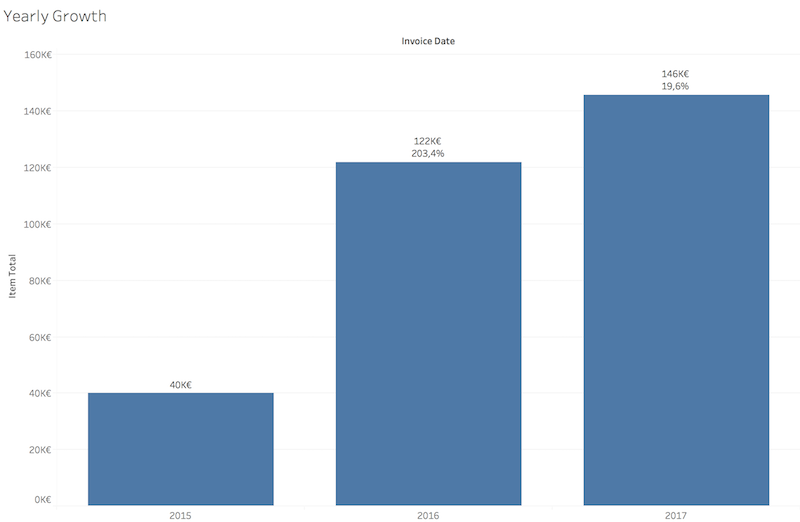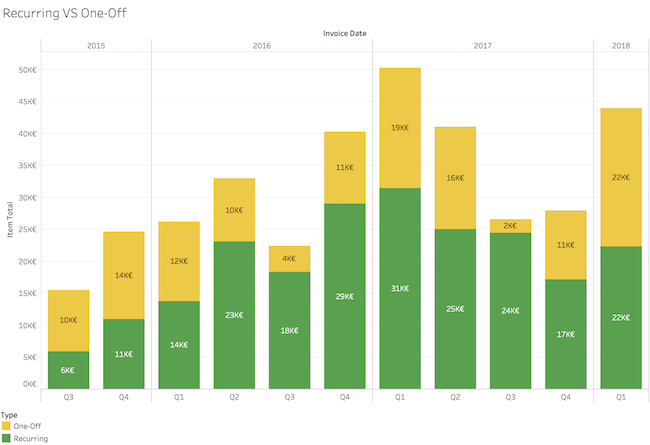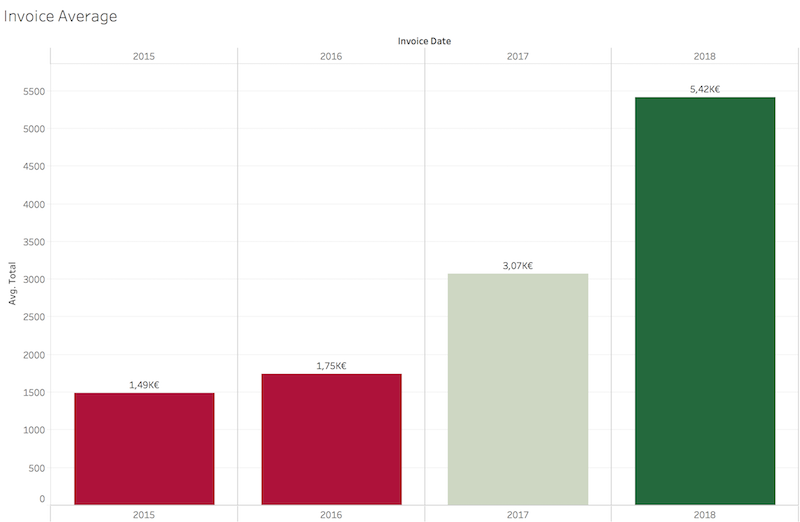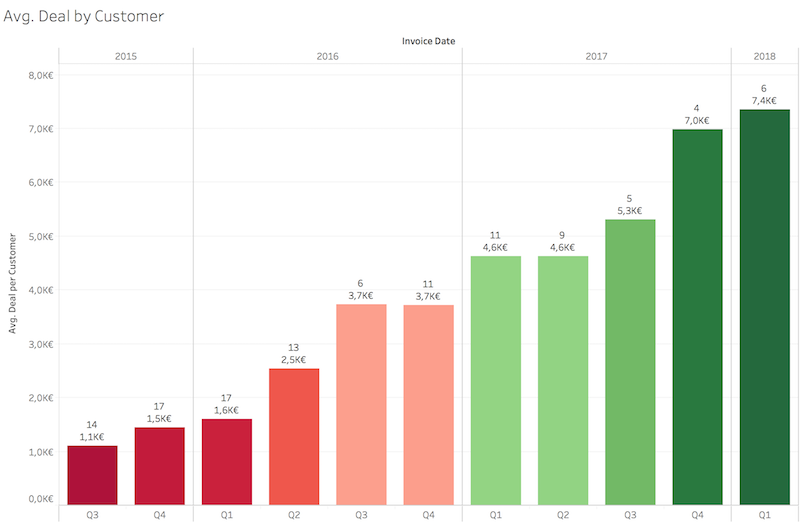10 Learnings Building a Consulting Practice to €150k+ per year
About 4 years ago, I tried to launch a business but failed without grace. The irony is that other entrepreneurs were asking me for advice. I quickly realized that I could help them grow their business. I also realized that I could make a good living out of it.
That’s how I got into consulting. Three years later, my business was thriving, but I decided to change paths. I decided to join a fast-growing company in the US.
Building a consultancy was a real challenge. I’ve made tons of mistakes along the way. Today, I’ll share some tips that will help you to go much faster and build a successful business.
If you want to be your own boss and build a consultancy, this article is for you.
Why am I moving?
After three years of consulting, I figured that I wasn’t learning as much as possible. I was still learning but I was hitting the law of diminishing returns.
I could have continued but I’d have had to find a narrower differentiation (see below). It would have been doable, but it’d have taken me 2-3 more years.
Instead of doing that, I thought that I’d learn more by joining a world-class team… Taking a new role and moving to a new country became obvious.
Where am I going?
I’ve decided to join MadKudu as their first Customer Success hire. In a nutshell, MadKudu increases sales efficiency & velocity by helping Marketing & Sales Operations with orchestration, automation & alignment throughout the customer journey.

The role was a perfect fit for me. I’ve been doing Growth Marketing as a consultant. I’ll now advise MadKudu’s clients on the best strategies they can use to grow their business.
I also moved to San Francisco so if you’re there and you want to talk shop or have coffee, send me an email or let’s connect on LinkedIn!
10 Learnings about Consulting Practices
I learned tons of stuff during these three years. If you’re building your own consultancy, I believe this will be helpful to you.
Differentiation is EVERYTHING
I was doing Growth Marketing for B2B SaaS. This was my differentiation. I focused on a specific market and I picked a vertical.
This was a good move. But it wasn’t enough. If you want to really grow as a consultant, you need to be as specific as you can.
Being a generalist can work if you have a good network and you’re good at your craft. However, you’ll be struggling to acquire clients and grow your business.
If you really want to build a sustainable business, you need to become the go-to person for a specific subject. The one who gets invited to speak at all the conferences.
Some of the benefits of being really specific include:
- It becomes easy to market your services because you know your customers so well
- It’s easy to service your customers because you solve the same problems over and over again
- You can charge more because you’re the recognized expert in your niche
If you want to learn more about differentiating yourself, I’d recommend reading the work of Philip Morgan.
Be Patient
When I initially started, I set out to make 200k€ / year. Thas was the amount of money that would allow me to comfortably hire someone.
I thought that it’d take me 2 years to get to that point. This goal wasn’t completely off-the-charts, but the timeline was. Here is what my revenue figures looked like:

I started invoicing in July 2015 but after two years, I wasn’t still making this goal. I’d have finished 2018 at roughly 180k€. Getting close to my goal, but not there yet.
My business grew by 20% year over year. Knowing my baseline, it would have taken me 3 years to reach 200k€ / year.
It takes time because you need to understand your customers at a deep level and understand how to sell yourself.
Building a consulting practice isn’t as fast as building a startup so be prepared to give it 3-5 years. If not more.
Go for recurring revenue
Recurring revenue wasmy business’ barebone. Roughly 70% of my revenue was recurring. Some months I already had 10k€ committed before the month even began.
Here is a graph of my quarterly revenue. Green bars are recurring revenue while yellow bars are one-off projects.

Having that much revenue already committed really relieved some stress. If you begin the month at 0€, you’re likely to:
- Take on projects even if you aren’t a good fit
- Take on projects even if the customer’s budget is really low
- Stop any long-term Marketing activities (because you’re drowning in low-value projects)
This ends up being bad for your business. Go for recurring revenue. As much as you can.
Even if you’re into one-off projects, you should be able to build some recurring components. Try finding these as they can easily make or break your business.
Go for value pricing
If you price your services based on the amount of time you think each project is going to take, you’re not maximizing your profits. You need to price your services based on the value delivered.
When a client comes to you, they need a problem solved. Whether it takes you 1 or 78 days is irrelevant to them. They want their problem solved as quickly as possible.
One Monday morning, a client called me and said “there is an issue with our main lead source, if we don’t do something now, we’ll loose 30k€ this month”. I flew to their offices on Wednesday and held a workshop for 5k€.
We solved the issue in 3 hours. The lead source picked up again and they made the 5k€ back in 3 days. Should I feel bad because I charged 1.6k€ per hour? Absolutely not.
The time that you spend on a project is irrelevant. Your customers would rather pay more to have their issues solved more quickly and with less risk. So, factor that into your pricing.
There are tons of great resources about value pricing, but I’d definitely recommend reading Jonathan Stark on the subject.
Don’t lower your price
If there is anything you should be doing with your pricing, it’s to increase it.
Is someone asking for a lower price? Are you worried you’ll lose the deal? There are several options here:
- You didn’t communicate your value clearly
- They don’t really have a need for the problem you’re solving
- They aren’t the right fit
Each time I lowered my prices, it ended up being a bad deal.
As you get more clients, you should become better and faster at solving problems for them. You’re reducing their risks. Thuss increasing your price makes sense.
If we look at when I started, my invoice averaged at 1.5k€. When I closed the business, I was charging more than 5k€.

There is a bias here: my clients trusted me with bigger problems and I could charge more. On the other hand, if someone had come to me and asked for 2015 prices, I wouldn’t have taken the deal…
As you create more and more value for your clients, always increase your price and never settle for less.
It’s all about relationships
This is an easy one. But I can only confirm it. You may have the best online presence or the best skills on the market, if you’re bad at building relationships, you’re gonna have a hard time building a consultancy.
You need to build strong relationships over the long term. Provide value to strangers. Go to conferences. Have coffee with people even if they’re a bad fit (now). You need to network.
Besides networking, you need to invest in your clients and make sure you keep the relationship going.
As my business progressed, I ended up working with a very small number of select clients. These (awesome) people trusted me and they were paying good money for that.

When I first started, 14 clients would pay me 1.1k€ each. At the end, 6 clients would pay me 7.4k€ each.
This is good because:
- You can focus your attention on your best customers
- You can avoid the stress of having “too many people” on your plate
This can also bad because whenever you lose a customer, you lose a big chunk of revenue. But that’s the game of being in the service business.
Never forget that relationships are at the center of your business and you need to deepen these relationships. Every. Single. Day.
Build trust in phases
When I started, I sometimes lost customers because I was sending proposals for 10k€+. These people didn’t know me and I was asking for way too much.
After a while, I realized that it’s always best to start a relationship on “short and small engagements” to get started and understand specific problems.
As soon as you start showing your value, customers will start trusting you more and you’ll be able to take on bigger projects (and charge more).
When building trust, start by selling small. You’ll increase your value later on.
It’s all about your process
You learn tons of stuff as you do more work. You need a way to document all that so that you keep improving your processes.
Build these processes for signing or onboarding clients but also for doing the work itself. At the end, I had checklists for every kind of problem I was solving.
This helped me reduce stress and to make sure I wasn’t starting from scratch everytime I was doing something.
Start small and you’ll iterate over time. But you need to start now!
Be clear about your long-term goals
Whether you want to build a 20-people business or a one-man shop, you need to be clear about what you want to achieve.
It’s perfectly fine if you just want a small income to support your family. However, you won’t be investing your time the same way if you want to build a larger business.
Being really clear about your goal will enable you to make sure you invest your time on the right things.
Limit the number of projects you take
More than one time, I took on a project only to realize that the workload for all my projects combined was a little more than I could handle.
This stressed me out. Because I was always worried that I couldn’t deliver on time and I ended up being on my computer way more often than I wanted.
It’s easy to get caught up in projects and take too many all at once. Pay attention to your workload and never forget to live.
The Good and The Bad
If you want to get into consulting, this section is for you. I wanted to highlight some of the pros and cons of being a consultant.
The Good stuff
- You get to be your own boss and work when you choose. You can also travel when everybody else is in their office.
- You get paid good money to solve problems that you know how to solve (and that you’re passionate about).
- Your business can pay for some of your personal expenses (e.g. trips, restaurants).
- You get to meet tons of very interesting founders and executives.
The Bad stuff
- As a general rule of thumb, your income is directly tied to the amount of work you do (cf. value pricing).
- You aren’t being challenged by many people since you’re working by yourself.
- It’s a slow growth so don’t expect to make millions in a few months.
- It’s hard to grow and it doesn’t scale well.
Every kind of business. Every kind of job. Will have its own pros and cons. The most important thing is to be mindful about them and to choose what suits you best at the time.
The 3-year conclusion
Being a consultant was an awesome experience. If you want to be your own boss and enjoy all the freedom that comes with it, you should definitely consider it.
Pay attention to all the subjects mentioned here because it can get hard at times. Be mindful about your work and make sure that you’re making good progress towards your goals.
I’m grateful to all the people that helped me and trusted me to solve their problems.
- Ilan Koskas
- Gabriel Gourovitch
- Jean-Christophe Lavocat
- Aude Sanchez
- Paul Polyakov
- Youri Jedlinski
- Benjamin Tierny
- Gijs Nelissen
- Jesse Wynants
- Romain Lamaison
- Michael Balyasny
- Moritz Dausinger
- Many more!
I’m also grateful to Sam Levan, Francis Brero and Paul Cothenet for giving me an awesome opportunity.


Leave A Comment